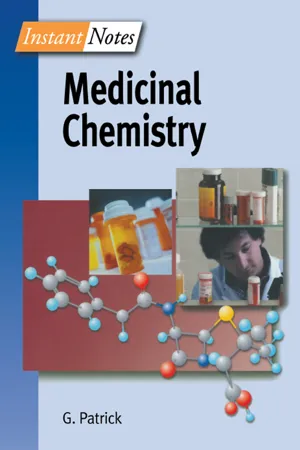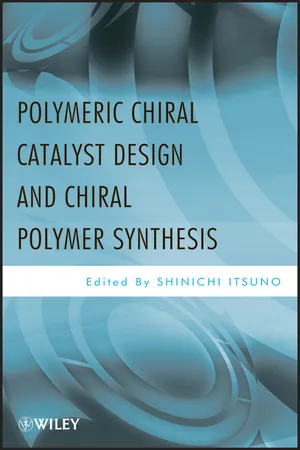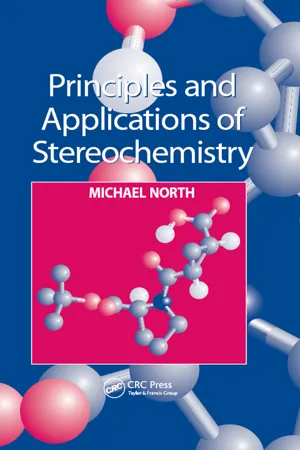Chemistry
Enantioselective Synthesis
Enantioselective synthesis is a chemical process that produces a single enantiomer of a chiral compound, yielding a product with high optical purity. This method is crucial in pharmaceutical and agrochemical industries, as it allows for the production of specific enantiomers with desired biological activities. Enantioselective synthesis often involves the use of chiral catalysts or reagents to control the stereochemistry of the reaction.
Written by Perlego with AI-assistance
6 Key excerpts on "Enantioselective Synthesis"
Learn about this page
Index pages curate the most relevant extracts from our library of academic textbooks. They’ve been created using an in-house natural language model (NLM), each adding context and meaning to key research topics.
- eBook - ePub
- Graham Patrick(Author)
- 2019(Publication Date)
- Taylor & Francis(Publisher)
There are two approaches to obtaining single enantiomers. One can either synthesize a racemic mixture of the drug using conventional methods, then separate the enantiomers, or one can use reagents that will produce one enantiomer in preference to the other – a process known as asymmetric synthesis.Asymmetric synthesis
Asymmetric synthesis involves the selective synthesis of one enantiomer of a chiral product. In order to achieve this, there must be an element of asymmetry present in the reaction. This means that either the starting material or the reagents used in the reaction must be chiral. Asymmetric syntheses are usually longer than conventional syntheses and are more demanding since it is necessary to avoid conditions that are likely to cause racemization (e.g. strong heat or the presence of strong base). The criteria for a good asymmetric synthesis is that the final product should be obtained in both a high chemical yield and a high optical yield. The latter is a measure of how enantioselective the reaction has been and is also called the enantiomeric excess (e.e.). For example, an optical yield of 90% means that 90% of the product is a single enantiomer, while 10% is a racemate. This corresponds to an enantiomeric ratio of 95:5 for each enantiomer. Ideally, reactions should have an enantiomeric excess which is greater than 98%. Another requirement of a good asymmetric synthesis is that any expensive chiral reagents used in the reaction must be present in catalytic amounts, or else recoverable with high yield and high purity so that they can be recycled.Asymmetric synthesis from chiral starting materials
If the starting material is chiral, then the asymmetry already present can often influence a reaction which creates a further asymmetric center, such that one configuration is preferred over the other. A case in point is the Grignard reaction shown in Fig. 7 , which is carried out as part of a synthesis leading to a sedative called etorphine - eBook - ePub
- John Andraos, Albert S. Matlack(Authors)
- 2022(Publication Date)
- CRC Press(Publisher)
Ideally, the product would be made in 100% ee so that no crystallization would be needed and no losses would occur. In practice, this seldom happens. To be useful commercially, the ee should be over 90% so that a minimal number of crystallizations will provide the pure optical isomer. Many of the reactions reported in the literature do not meet this standard. However, they may be important mileposts on the way to high enantioselectivity. Despite the successes of computational chemistry in many areas, it is still not possible to model the transition states of the reactions well enough to select catalyst that will provide high stereoselectivity. Most of the good catalysts are found empirically and raised to high selectivity by systematic variation of the substituents. (Some variations are done to get around existing patents.) The application of combinatorial chemistry may help. Rather than finding a general catalyst that gives high enantioselectivity and yields for a whole class of compounds, it may well be necessary to tailor the steric and electronic effects in each one to a specific substrate and set of conditions, Reasonable turnover rates are also required for the catalysts. Some of the better methods of asymmetrical synthesis will be described in the following, together with their advantages and limitations.The use of enzymes in enantioselective reactions71 was covered in Chapter 9 and earlier in this chapter. Most single-isomer products are still made by chemical methods. Chemists are becoming more familiar with biocatalysis, and it can be expected to supplant some of the chemical methods.Chiral auxiliaries are often used on a stoichiometric basis. They are often derived from natural amino acids and the amino alcohols obtained by their reduction.72 A typical alkylation reaction (Scheme 10.34 ) carried out in this way is shown.73 (Similar alkylations have been carried out using polymeric analogs, the ee varying with the resin used [up to 90% ee when Wang resin was used].)74SCHEME 10.34Example enantioselective alkylation reaction using a chiral auxiliary.The starting compound was also condensed with an aldehyde in 82%–84% yield with more than 98% ee. A corresponding amide from an α, β-unsaturated acid underwent the Diels-Alder reaction in 86%–90% yield with more than 99% ee. The original amino alcohol was probably treated with phosgene to close the oxazolidone ring.75 The less toxic dimethyl carbonate might be a suitable replacement for the phosgene. The use of another chiral auxiliary for alkylation is shown in Scheme 10.35 .76 - Ahindra Nag, Ahindra Nag(Authors)
- 2018(Publication Date)
- CRC Press(Publisher)
1 Basic Stereochemical Approaches to Natural Products and Drugs Ahindra NagCONTENTS 1.1Basic Concept of Chirality 1.2Meso Compounds 1.3Tautomerism and Valance Tautomerism 1.4Conformation 1.5Fischer Projection and Absolute Configuration 1.6Chiral Resolution 1.6.1Crystal Picking 1.6.2Chemical Separation 1.6.3Biochemical Separation 1.6.4Chromatographic Separation 1.7Application of Enantiomers in Drugs and Natural Products Problems Answers References1.1Basic Concept of Chirality
An asymmetric carbon atom (known as the stereogenic center) is attached to four different groups1 termed a chiral (pronounced as kiral). The word chiral derives from the Greek word cheira meaning hand, which is closely related to optical activity. For a molecule to have chirality, it must not possess a plane, a center, or a fourfold alternating axis of symmetry. Molecules which are mirror images of each other are termed enantiomers (from the Greek entatios meaning opposite) and need chiral recognition to be separated. Enantiomers react1 , 2 , 3 , 4 , 5 , 6 at different rates with other chiral compounds and may have different solubilities in the presence of an optically active solvent. They may display different absorption spectra under circulatory polarized light. Enantiomers may have different optical rotations, which could be either (+), that is, dextrorotatory (clockwise), or (−), that is, levorotatory (anticlockwise), and can be determined by a polarimeter. The optical purity of a mixture of enantiomers is given by% Optical purity of sample = 100 ∗Specific rotation of sampleSpecific rotation of a pure enantiomerwhereSpecific rotationα D=α obs/c lαobs is the experimentally observed rotationc is the concentration in g/mLl is the path length of the cell used, expressed in dm (=10 cm)Enantiomeric excessis one of the indicators of the success of an asymmetric synthesis. The enantiomeric excess (eep7- Shinichi Itsuno, Shinichi Itsuno(Authors)
- 2011(Publication Date)
- Wiley(Publisher)
th century, organic chemist has been practicing chemical reactions in homogeneous media. It took around 100 years to create the first completely synthetic polymer and an additional 50 years to put forth the revolutionary concept of performing organic reactions on a polymer support. The organic synthesis on polymer support was initially developed to prepare peptide and oligonucleotide libraries [1]. Later, with more advances, chemists designed and synthesized small molecules on a polymer support 2. During this revolution, as required by the pharmaceutical industry, organic chemists learned the significance of solid-supported parallel and combinatorial synthesis required for the lead generation to accelerate the drug discovery process. By employing various new methodologies for high-throughput synthesis, combinatorial chemistry has developed a new paradigm for the chemical synthesis of small molecules 3. It has changed the way in which drug discovery was conducted in a pharmaceutical industry [4]. Many pharmaceutically active compounds contained a chiral core inside the structure. Recent findings also revealed that both the complexity as well as the presence of chiral centers in the molecule correlate with success as compounds transition from discovery, through clinical testing, to drugs [5], which demands the design of enantioselective combinatorial libraries. This new approach of synthesizing chiral combinatorial libraries on polymer support will lead to a breakthrough in modern drug discovery.Enantioselective Synthesis of polymer support can be designed in various ways (Figure 6.1 ). Figure 6.1(a) describes a polymer-supported enantioselective catalysis in which the polymer-supported chiral catalyst can be used in a routine solution phase synthesis. Several highly reactive polymer-supported chiral catalysts and reagents have recently been developed for a variety of reactions, and excellent enantioselectivities in many asymmetric reactions have been obtained by using these catalysts [6]. The other way to perform Enantioselective Synthesis is to use polymer-supported chiral auxiliaries [Figure 6.1(b) ]. A chiral auxiliary is temporarily incorporated into an organic synthesis so that it can be carried out asymmetrically with the selective formation of one of the enantiomers. It actually serves as an anchoring group and allows for diastereoselective transformations on the immobilized building blocks. This classic approach was well executed using polymer-supported auxiliaries 7. Kindly refer to Chapters 2 and 3 in this book for more details about approaches A and B.Figure 6.1 Chiral synthesis on polymer supports.Approach C is the straightforward technique of performing asymmetric synthesis on a polymer support and closely resembles the chiral pool synthesis. In this approach, a chiral starting material is manipulated through successive reactions using achiral reagents while retaining its chirality to obtain the desired target molecule. Whereas, approach D is the polymer-supported version of the widely recognized asymmetric catalysis. During the last 10 years, several research groups have demonstrated the use of asymmetric catalysts for the total synthesis, suggesting that the asymmetric synthesis on a solid-phase support is possible and that results comparable with solution-phase methods can be obtained [8].- eBook - ePub
- Michael North(Author)
- 2017(Publication Date)
- Routledge(Publisher)
Asymmetric Synthesis ( R.A.Aitken and S.N.Kilényi eds). Chapman and Hall:London, 1992.Enantioselective Reactions in Organic Chemistry O. Cervinka. Ellis Horwood:London, 1995.Asymmetric Synthesis Vol. 2 ( J.D.Morrison ed.). Academic Press:London,1983.Asymmetric Synthesis of Natural Products A.Koskinen. Wiley: Chichester,1993.Principles of Asymmetric Synthesis R.E. Gawley and J.Aubé. Pergamon:Oxford, 1996.Asymmetric catalysisAsymmetric Catalysis in Organic Synthesis R.Noyori. Wiley: Chichester, 1994.Enzyme catalysed reactionsEnzymes in Synthetic Organic Chemistry C.-H.Wong and G.M.Whitesides. Pergamon:Oxford, 1994.Biotransformations in Preparative Organic Chemistry H.G.Davies, R.H.Green, D.R.Kelly and S.M.Roberts.Academic Press: London, 1989.H.Stecher and K.Faber. Synthesis, 1997, 1.The chiral poolAsymmetric Synthesis Vol. 4 ( J.D.Morrison and J.W.Scott eds). Academic Press: London, 1983, chapter 1.The Evans auxiliaryD.J.Ager, I.Prakash and D.R.Schaad. Aldrichimica Acta, 1997, 30, 3.Asymmetric amplificationM.Avalos, R.Babiano, P. Cintas, J.L.Jiménez and J.C.Palacios. Tetrahedron Asymmetry, 1997, 8, 2997.10.5 Problems1. Draw reaction pathway/energy diagrams for the reactions shown in Scheme 10.2 and Scheme 10.3 . Your diagrams should show each reaction intermediate and transition state and clearly indicate any differences between the pathways leading to the two enantiomeric products.2. Which of the following compounds will give an enantiomerically pure product when used instead of propanal in the reaction sequence shown in Scheme 10.2 .3. Despite not containing a prochiral methylene group adjacent to the carbonyl group, aldehyde A does give an enantiomerically pure product when subjected to the reaction sequence shown in Scheme 10.2 - eBook - ePub
- Takayuki Shioiri, Kunisuke Izawa, Toshiro Konoike(Authors)
- 2010(Publication Date)
- Wiley-VCH(Publisher)
Indeed, biocatalysis is receiving an increasing attention not only because it can very well address the above described needs for sustainable manufacturing solutions with respect to cost, quality, and ecologic footprint but also because of the groundbreaking technological breakthroughs in enabling technologies that happened during the last 10 years. For example, our ability to clone DNA from environmental samples (metagenome) [4], breakthroughs in enzyme engineering by evolutionary design [5], exponentially reduced cost, and increased speed of DNA sequencing [6] and synthesis [7] led to an exponential increasing number of available enzymes and an accelerated development speed as well as reduced development costs.This chapter focuses on enzymatic concepts enabling the synthesis of chiral molecules in up to a theoretical 100% yield and >99% ee. Such concepts are very much preferred, from an economic as well as ecologic perspective, over resolution concepts which generate either 50% waste or requiring costly and waste generating recycling steps. The discussed concepts are divided into (i) asymmetric synthesis, (ii) desymmetrization, (iii) deracemization, and (iv) dynamic kinetic resolution (DKR) concepts. Asymmetric introduction of oxygen by oxygenases which also enables 100% yield and 100% ee concepts is, however, beyond the scope of this chapter. The interested reader is referred to some excellent reviews that have been published elsewhere (8, 9, 10).The aim of this chapter is not to be comprehensive but to provide an overview on some general concepts, discuss recent progress, and highlight industrially relevant examples of processes that are operated on a significant scale to demonstrate the practical use of the described approaches.16.2 Asymmetric Synthesis Asymmetric synthesis





